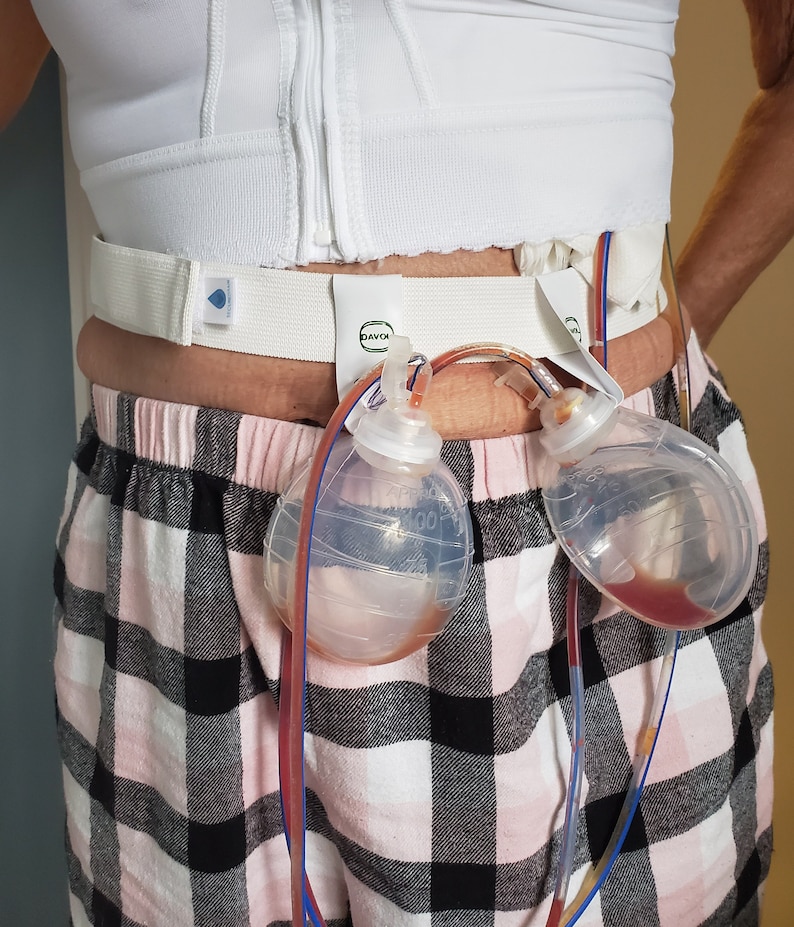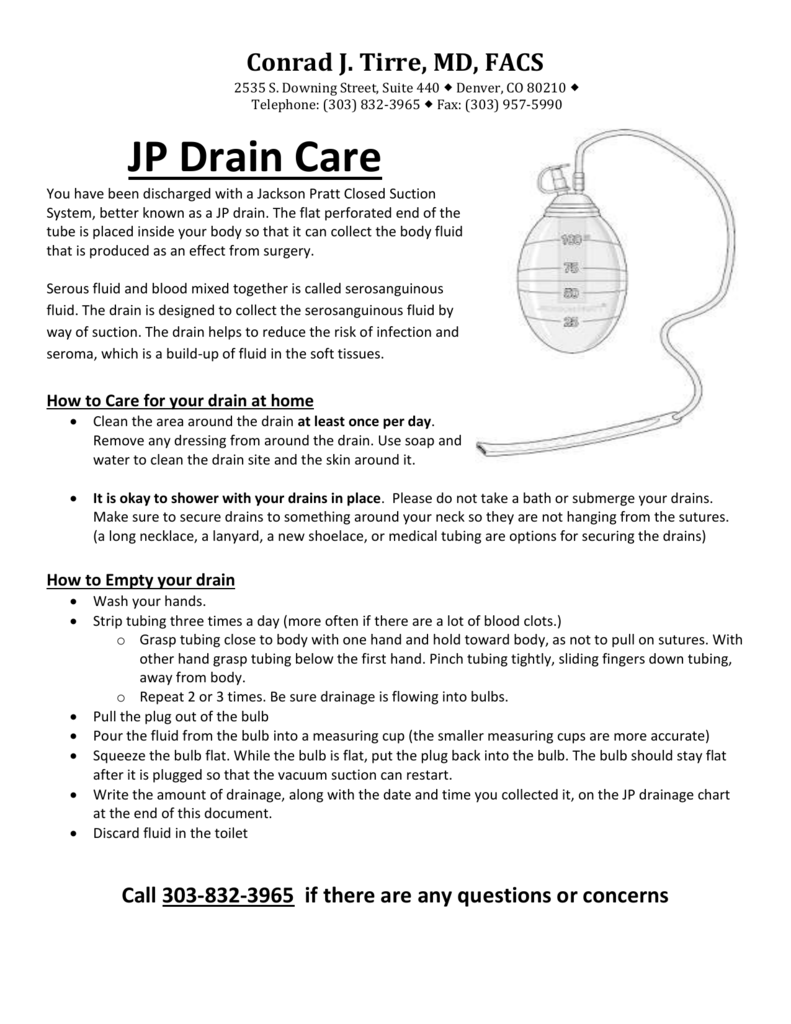Jp drain care information
Home » Trend » Jp drain care informationYour Jp drain care images are available. Jp drain care are a topic that is being searched for and liked by netizens now. You can Download the Jp drain care files here. Find and Download all royalty-free photos.
If you’re looking for jp drain care pictures information connected with to the jp drain care keyword, you have come to the right blog. Our website frequently provides you with hints for viewing the maximum quality video and picture content, please kindly search and find more informative video articles and graphics that fit your interests.
Jp Drain Care. Jp drains are often placed in wounds during surgery to prevent the collection of fluid underneath the incision site. You may shower in _____ days. You drain less than 30 milliliters (2 tablespoons) in 24 hours. • loosen the tape and remove the old dressing from the drain.
 How To Flush Jp Drain Best Drain Photos From primagem.org
How To Flush Jp Drain Best Drain Photos From primagem.org
Loosen the tape and gently remove the old bandage. This may mean your drain can be removed. Jackson pratt (jp) drain jp drains are often placed in wounds during surgery to prevent the collection of fluid underneath the incision site. The drain (s) promote healing by keeping excess pressure off the incision and decreasing the risk of infection. They do not have to be sterile. Throw the old bandage into a plastic trash bag.
In this training, we�ll review the equipment and procedures for jp drain emptying, suction reactivation, insertion site dressing, and drain removal.this course includes.
Drain the fluid into a measuring cup. Drain the fluid into a measuring cup. Prepare a clean area to work on. Jp care instructions 6) 1) wash your hands thoroughly with soap and water before touching drain. A jp drain has a thin, flexible rubber tube that sits under the skin in the area under or near the incision. Most hospitals have specific protocols on how you are to care for a jp drain.
 Source: pressbooks.bccampus.ca
Source: pressbooks.bccampus.ca
(please see sample of jp drain log below.) pour the fluid contents into the toilet. Lift the opening on the drain. Wash your hands well with soap andsurgery. You have a fever higher than 101.5°f (38.6°c). How to care for a jp drain as a nurse.
 Source: nurseshealthcorner.blogspot.com
Source: nurseshealthcorner.blogspot.com
Increasing drainage from the jp bulb that continues longer than two to three days; When you empty a jp bulb, unplug the stopper and empty the contents into a cup that is marked with milliliters. Often the skin and tube are sutured (stitched) together to ensure the jp drain does not move from under the skin. (please see sample of jp drain log below.) pour the fluid contents into the toilet. Include the date and time it.
 Source: etsy.com
Source: etsy.com
You will be given a measuring cup—empty the fluid into this. Care for area(s) where the tube enters my skin. • remove the plug from the bulb. Milking your tubing to help move clots. Jp drains are often placed in wounds during surgery to prevent the collection of fluid underneath the incision site.
 Source: primagem.org
Source: primagem.org
Starting the day after your drain has been pulled, removed the old dressing, cleanse the area with a new bottle of peroxide and water (50/50), apply the antibiotic ointment to the gauze &/or band aid and then apply that to the area where the drain was pulled. Use the chart below to record the amount of fluid collected every time you empty your jp bulb. Record the amount of fluid each time you empty the drain. Empty it more often if the drain is full. They do not have to be sterile.
 Source: etsy.com
Source: etsy.com
Please record the time and amount of fluid. From clogging and keeps the jp drain working correctly. Please record the time and amount of fluid. 3) remove the old dressing. Empty it more often if the drain is full.
 Source: wikihow.com
Source: wikihow.com
Include the date and time it. Squeeze the center of the bulb and recap with the drain plug before releasing. Jp drains are often placed in wounds during surgery to prevent the collection of fluid underneath the incision site. Record the amount of fluid and discard the fluid in the toilet. Empty your drain at least twice a day.
 Source: youtube.com
Source: youtube.com
Throw the old bandage into a plastic trash bag. Keep drain pinned to clothing to prevent pulling and discomfort. Record the amount of fluid each time you empty the drain. You might try using a fanny pack to secure the jp drains around your waist. The drain is sutured (stitched) in place at.
 Source: primagem.org
Source: primagem.org
• use soap and water to gently cleanse the skin around your jp drain site. It is best to milk and drain the jp system three times a day. They do not have to be sterile. You drain less than 30 milliliters (2 tablespoons) in 24 hours. Therefore, follow these protocols and always refer to these protocols before providing any care to a jp drain.
Source: howtorem.blogspot.com
Strip the drains using an alcohol swab and empty three times daily or whenever drain appears full. Include the date and time it. This can be done in your bathroom or in an area with a dry, uncluttered surface. During a mastectomy the breast is separated from subcutaneous tissue and muscle. Strip the drains using an alcohol swab and empty three times daily or whenever drain appears full.
 Source: lilianaescaner.blogspot.com
Source: lilianaescaner.blogspot.com
At the end of the tube is a small squeeze bulb. From clogging and keeps the jp drain working correctly. Jp drains are often placed in wounds during surgery to prevent the collection of fluid underneath the incision site. Please record the time and amount of fluid. Jp care instructions 6) 1) wash your hands thoroughly with soap and water before touching drain.
 Source: pinterest.de
Source: pinterest.de
In this training, we�ll review the equipment and procedures for jp drain emptying, suction reactivation, insertion site dressing, and drain removal.this course includes. In this training, we�ll review the equipment and procedures for jp drain emptying, suction reactivation, insertion site dressing, and drain removal.this course includes. Starting the day after your drain has been pulled, removed the old dressing, cleanse the area with a new bottle of peroxide and water (50/50), apply the antibiotic ointment to the gauze &/or band aid and then apply that to the area where the drain was pulled. 3) remove the old dressing. How do you empty the drain?

At the end of the tube is a small squeeze bulb. Strip the drains using an alcohol swab and empty three times daily or whenever drain appears full. This can be done in your bathroom or in an area with a dry, uncluttered surface. The drain(s) promote healing by keeping excess pressure off the incision and decreasing the risk of infection. Record the amount each t ime.
 Source: wikihow.com
Source: wikihow.com
(please see sample of jp drain log below.) pour the fluid contents into the toilet. If you have more than 1 drain, make sure to measure and write down the drainage of each one separately. Increasing drainage from the jp bulb that continues longer than two to three days; Drainage in the bulb, call your healthcare provider. Wash your hands well with soap andsurgery.
 Source: pinterest.com
Source: pinterest.com
It is best to milk and drain the jp system three times a day. 3) remove the old dressing. Jackson pratt (jp) drain care: There are different types of drains. • remove the plug from the bulb.
 Source: researchgate.net
Source: researchgate.net
Wash your hands well with soap andsurgery. Often the skin and tube are sutured (stitched) together to ensure the jp drain does not move from under the skin. Pin the drains to anchor them. Proper jp drain care is essential to your physical recovery. This way, they won�t get tangled or pulled out.
 Source: etsy.com
Source: etsy.com
Jp drains that are attached to clothing may also feel more comfortable. If you have more than 1 drain, make sure to measure and write down the drainage of each one separately. Often the skin and tube are sutured (stitched) together to ensure the jp drain does not move from under the skin. This can be done in your bathroom or in an area with a dry, uncluttered surface. How do you empty the drain?
 Source: studylib.net
Source: studylib.net
(only when instructed to do so, squeeze (strip) the drain tubing with alcohol swab toward the bulb prior to emptying it as instructed by nurse or provider.) Caring for my jackson pratt (jp) drainage system education plan 3 milking (stripping) the tubing If you have more than 1 drain, make sure to measure and write down the drainage of each one separately. Most hospitals have specific protocols on how you are to care for a jp drain. You have a fever higher than 101.5°f (38.6°c).
 Source: pinterest.com
Source: pinterest.com
You may shower in _____ days. 3) remove the old dressing. The drain is sutured (stitched) in place at. The purpose of the jp is for the tubing to lie next to the staple line, so in the unlikely event of a staple line leak , any gastric contents that leak out would be collected by the drain rather than forming an abscess. Dip a cotton swab or gauze pad in the solution and gently clean your skin.
This site is an open community for users to do submittion their favorite wallpapers on the internet, all images or pictures in this website are for personal wallpaper use only, it is stricly prohibited to use this wallpaper for commercial purposes, if you are the author and find this image is shared without your permission, please kindly raise a DMCA report to Us.
If you find this site convienient, please support us by sharing this posts to your favorite social media accounts like Facebook, Instagram and so on or you can also save this blog page with the title jp drain care by using Ctrl + D for devices a laptop with a Windows operating system or Command + D for laptops with an Apple operating system. If you use a smartphone, you can also use the drawer menu of the browser you are using. Whether it’s a Windows, Mac, iOS or Android operating system, you will still be able to bookmark this website.